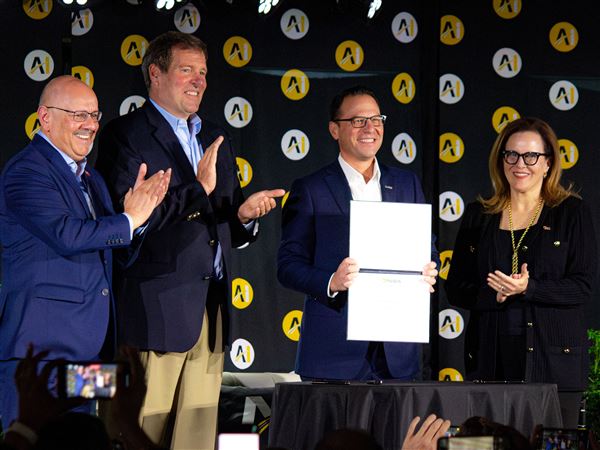A bitter, public war has erupted between grass-roots Holocaust survivor organizations and the United States Holocaust Memorial Museum over some 16 miles of Holocaust-era records held by the International Tracing Service at Bad Arolsen, Germany. The archive contains some 42 million records of the incarceration and enslavement of 17 million Nazi victims, about 70 percent of which are digitized. Until recently, the files were secret.
Edwin Black, author of "IBM and the Holocaust," has written frequently about the Bad Arolsen archives (www.ibmandtheholocaust.com/Bad ArolsenArticles.php.).
A 2006 treaty negotiated among the 11 nations of the International Tracing Commission that control the records calls for complete sets of copies to be distributed to each country. But France and Italy have yet to ratify it. Italian sources say their ratification process may take an additional year or two. That delay is heartbreaking to hundreds of thousands of elderly Holocaust survivors dying daily of old age and desperate to trace the fate of their loved ones.
Meanwhile, Bad Arolsen's files could be made Internet-ready within three to four months, according to senior ITS technology officials. But the U.S. Holocaust Memorial Museum, the prime mover in releasing the records internationally, is intent on sequestering the data in its own on-site terminals in Washington instead of making them available on the Internet or via a remote secure database accessible to Holocaust survivors in local libraries or their homes the way most government documents are accessible these days. The museum's physical-transfer approach involves a complicated, costly, time-consuming process of data exports, system reintegration and a computer infrastructure built from scratch. Once completed, Holocaust survivors and their families would have to travel to Washington to access the records or otherwise use the museum as a middleman.
The idea outrages Holocaust survivors.
"Where does the museum get the chutzpah?" asked David Schaecter, president of the Miami-based Holocaust Survivors Foundation. He and other survivors assert that the museum exploits its control of the collection to endlessly fund-raise in their name and, once the records are on site, to attract more visitors. Klara Firestone, founding president of Second Generation Los Angeles, said museum executives "have lost their sight and lost the soul of the museum."
In defending their decision, museum officials and their surrogates have spun any number of false statements and misinformation to unsuspecting reporters, Jewish leaders and key congressional staffers. They have misportrayed Red Cross officials as obstructionists, quietly villianized French and Italian lawmakers and told those unfamiliar with computer technology that Bad Arolsen's data is plagued by almost insurmountable software problems and is impossible to make Internet-ready. They even have implied that the international treaty prohibits Internet access.
The opposite is true. Red Cross and Bad Arolsen officials are fervently working to make their records accessible as soon as possible. During a historic video and telephonic "town hall meeting" of Holocaust survivors held June 18 at Nova Southeastern University, ITS director Reto Meister invited all to come to Bad Arolsen and access their personal files. The meeting was the first chance Bad Arolsen officials had to speak directly to survivors to dispel myths of noncooperation and unworkable software.
In a subsequent series of conference calls with me, followed by a written statement of technical specifications, Bad Arolsen Chief Technology Officer Michael Hoffman and archivist Udo Yost explained how their system works. Ten years in development, it uses three interactive sets of prisoner data, including images of Nazi-era prisoner cards. Mr. Hoffman confirmed that, given the correct name, birth date and birth city, "with a little luck, we get a hit on the full data set." Mr. Yost added, "If you are trained, it is quick, sometimes a matter of moments, maybe 10 seconds, maybe one minute." The system, Mr. Yost said, "does not need to be reinvented."
I asked a senior Red Cross technology officer if placing the Bad Arolsen files on the Internet was legal and feasible. "Of course," he said.
Indeed, all Bad Arolsen files are now being exported to XML, the ideal Internet-ready data language recommended by the World Wide Web Consortium, in preparation for transfer to the Holocaust Museum.
Moreover, a Swiss Red Cross official revealed that in March, France suggested to the commission that Bad Arolsen place its files on the Internet or on a secure "virtual private network," accessible by an unlimited number of terminals throughout the world. The Internet idea later was one of three technology options formally proposed by the Red Cross during a May conference of the commission in Amsterdam.
Asked why the nations attending the conference chose not to place all the files on the Internet, a Red Cross official who was directly involved replied, "Don't ask me. Technically it will be feasible to access these databases from anywhere in the world. We would just export to XML format. We could then support a virtually unlimited number of remote terminals. Member countries would not receive copies, just access. This option was not taken.
"Had they chosen the Internet option," he continued, "the records would be accessible in a matter of months. But our role is just to propose solutions ... and [it is] not our role to judge them."
Asked whether the Holocaust Museum supported the French proposal for Internet access, a key commission official declared cautiously, "Look, this entire process has been steered by one organization and one country: The Holocaust Museum and America. You must ask them."
Museum officials declined to be interviewed.
It is time for the museum to come clean with Congress, the media and Holocaust survivors. The museum must face the technological facts and get those files up on either a secure or generally accessible Internet connection so the victims can see them.
The miserable sagas contained within those files should not be used to drive more patrons to the museum, but to help the victims of the Holocaust rest in peace.
First Published: August 10, 2007, 6:30 p.m.














